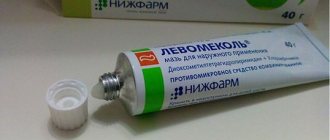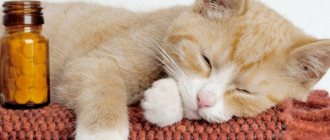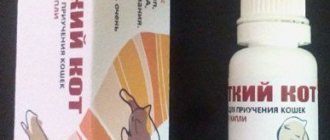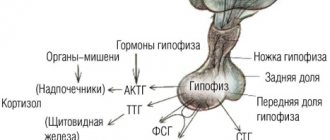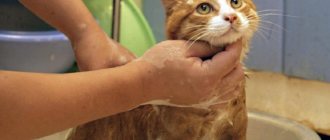Mechanism of action
Vaseline oil remains a topical remedy that helps combat constipation. It has the following actions:
- During constipation, stool loses moisture and becomes dry. The oil penetrates the stool, softens it, and makes the stool consistency close to normal.
- Has a weak stimulating effect on intestinal motility.
- Envelops the contents of the intestines and improves the evacuation of feces.
The drug does not have a strong taste or strong odor. The substance does not irritate the intestines. When taken orally, it is not absorbed through the intestinal mucosa, does not enter the bloodstream and does not affect the balance of intestinal microflora. These properties make it possible to give Vaseline oil to cats and kittens.
Description of Vaseline oil and how it works
global $ads_google; //data-ad-slot=”2475549904″ $ads_google = empty($ads_google) ? false : true; ?> if ($ads_google == false) {?>
$ads_google = true; ?> } ?>
Vaseline oil is safe for cats if given according to directions. You should study the issue of such assistance to your pet more carefully so that the treatment brings only positive results.
We are talking about a completely safe product that has neither color nor taste. It doesn't even smell. As a rule, its absorption leads to the fact that it leaves the body unchanged.
The Latin name of the product sounds like Oleum vaseline, which literally translates as vaseline oil. Chemically, it is a derivative of kerosene, which is obtained by purifying hydrocarbons after its production. Of course, the raw materials are filtered most carefully, freed from all impurities and become clear as water.
For cats, this is a surefire remedy for constipation. Its action is based on lubricating all parts of the intestines, covering them with a thin film, at the same time it helps to strengthen motility.
Using oil allows you to naturally remove hard feces without causing pain to your pet. The oil film will prevent feces from getting stuck or injuring the intestines, and toxins and fluid loss from food lumps are blocked.
The drug will not penetrate into the blood, and there is no allergy to it either. But hairballs will also more easily move towards the exit of the digestive tract.
The mild laxative effect quickly brings the pet's stool back to normal, calming both the sufferer and his owner.
You should not use the remedy for constipation often, as it can cause addiction and a decrease in intestinal tone.
When to give oil
If a cat does not go to the toilet for at least 3 days, this is a clear sign of constipation. Lack of stool is most often a problem in adult cats and newborn kittens that are poorly cared for by their mother or artificial breeders. The pet becomes lethargic, inactive, and may refuse to eat. If you watch a cat, you can see that it sits for a long time in the tray or nearby, pushing, but there is no result.
It is dangerous to hesitate. Constipation can provoke poisoning of the body and cause disruption of the digestive tract. The load increases on all organs, especially the heart, liver, and kidneys.
Giving Vaseline oil to a cat for constipation is the first thing an owner can do at home.
Enema
The use of a rectal enema with an oily product is acceptable in kittens and adult cats.
The product is used pure or diluted with water. After adding the product to the water, the solution should be shaken well and brought to a temperature of approximately 25-30 degrees. Hot or very cold liquid will cause discomfort to your pet.
The amount of solution is determined depending on the age and size of the animal:
- Vaseline oil for kittens is administered with a pipette. Usually 2 pipettes with a solution or 1 ml of pure substance are enough to obtain the effect. After giving the enema, veterinarians recommend helping the baby: giving a light tummy massage.
- For adult pets, a dosage of 5-12 ml of pure product or 250 ml of solution helps induce defecation.
To administer an enema, use a syringe (bulb) or a hose from an IV and a syringe. The tip of the device must be lubricated with cream and carefully inserted into the anus. The fluid is introduced slowly so as not to damage the rectum or cause pain.
The tip is also carefully removed from the rectum. If the enema does not work or black stool comes out (a sign of intestinal bleeding), you should consult a doctor as soon as possible.
Dosage
Of course, any drug must be given to the animal in the correct dosage. If you give a smaller dose, the medication simply will not work, and if you give a larger dose, there will be a risk of complications.
An adult cat is given 5-10 milligrams of oil. Bowel movement should occur within 3-4 hours from the moment of administration, depending on the severity of constipation and the individual characteristics of the cat’s body. If bowel movement does not occur, you can give another 5 milligrams of the drug. Be careful: the maximum daily dose should not exceed 20 milligrams.
For kittens, the dose should vary depending on weight, in the proportion of 1 milligram of the substance per 1 kilogram of weight, and in total no more than 5 milligrams of oil can be given per day.
© shutterstock
Oral administration
For constipation, treatment begins by giving the cat oil orally. The drug is injected with a syringe without a needle directly into the mouth. The pet may resist. Therefore, you need to take him on your lap or wrap him in a towel/blanket. You may need to open his mouth. To do this, place your thumb and index finger behind the fangs and spread the jaw.
It is necessary to pour in the liquid very carefully so that it does not enter the respiratory tract. The cat's head should be raised up, but not thrown back, otherwise the animal will choke. A mistake can lead to the death of your pet, as oil entering the lungs causes swelling.
To minimize the risk, the syringe is placed in the corner of the mouth, behind the canine. You need to inject no more than a milliliter at a time so that the cat can swallow and not choke. After the medicine is completely squeezed out of the syringe, you need to cover the cat's mouth, otherwise it will spit out the liquid. Stroking her neck will help her swallow the remaining product.
A little about constipation and its causes
To prevent constipation, you need to create a balanced diet for your pet, monitor the amount of water he drinks per day, because a lack of fluid contributes to the compaction of feces. The feed must contain fiber.
Make your pet move more: a lazy lifestyle negatively affects intestinal function, causing intestinal atony.
You should not self-treat your pet, as overuse of oil will not only worsen the problem, but may also cause the death of your beloved cat. Only a veterinarian, after a special examination aimed at identifying the cause, will be able to eliminate the disease with the help of proper treatment.
Author of the article: Marina Nikolaevna Chuprina, veterinarian, parasitologist
Constipation is difficult bowel movement in a cat for a long time (more than two days). In this case, the feces lose moisture, become compacted and cannot come out naturally, clogging the lumen of the digestive tube. Naturally, the condition causes discomfort in the pet:
- he is worried;
- periodically meows pitifully;
- often goes to the litter box, but all attempts to do a “big thing” remain unsuccessful.
Moreover, a prolonged absence of bowel movements will lead to intoxication of the body, which will negatively affect the functioning of internal organs and systems.
The causes of constipation are varied, but the dominant role in their occurrence is played by errors in feeding, when the diet contains a large amount of dry food or, even worse, bones, and little water enters the body.
Other reasons:
- intestinal atony;
- postoperative rehabilitation;
- blockage;
- twisting of intestinal loops.
For more information about constipation in cats, its causes and treatment, read this article.
Restrictions on use
Vaseline oil is often used for constipation in cats. However, despite its safety, the product has restrictions on its use. This applies to both enemas and when taken orally.
Before giving Vaseline oil to a cat, you need to consider contraindications and possible consequences:
| Contraindications for use | Pregnancy. May cause reflex contractions of the uterus. During lactation, use is permitted. |
| Individual intolerance. | |
| The pet has swallowed an object or bone | |
| If constipation is accompanied by high temperature (above 39 degrees). In this case, stool retention is a symptom of other diseases. | |
| Intestinal volvulus. | |
| Gastrointestinal diseases accompanied by an inflammatory process. | |
| Side effects | Decreased intestinal muscle tone. |
| Itching and irritation in the anal area. | |
| Nausea, vomiting. | |
| Diarrhea (if the dosage is exceeded). | |
| Features of application | If you give your cat oil internally, after some time it will begin to secrete from the anus. Therefore, the fur under the tail will become dirty. The owner will need to wipe the fur with gauze or a cotton pad. |
Contraindications
Contraindications to taking petroleum jelly are:
- pregnancy;
- intestinal bleeding, volvulus;
- infectious pathologies of internal organs;
- feverish conditions;
- heat;
- stomach ulcer;
- pregnancy;
- individual intolerance.
Frequent use is also a contraindication, as it reduces intestinal tone and makes it difficult for cats to have independent bowel movements.
Bimin
For cats and dogs, the drug Bimin is produced based on petroleum jelly. It is prescribed both for therapeutic purposes, to normalize stool, and for preventive purposes.
The drug is an oily liquid without color, odor or taste. The product gives a mild laxative effect:
- softens feces and promotes their evacuation;
- removes balls of hair (trichobezoars).
- normalizes the functioning of the gastrointestinal tract.
Taking Bimin does not cause discomfort or pain in animals. The composition contains only natural ingredients. Bimin does not cause allergies and does not penetrate into the bloodstream.
The instructions recommend giving the drug to the animal once in the morning. Dosage – 1 ml per 1 kg of weight. When using the product in accordance with the instructions, no side effects are detected. Even if the dose is accidentally exceeded by 3 times, there will be no danger to the cat’s health.
Preventing constipation
The best way to protect your animal from constipation is prevention:
- You need to reconsider your diet. Switch to super-premium food. When feeding naturally, increase the amount of foods containing fiber.
- Make sure your pet drinks water, especially when eating commercial food.
- Try to increase the animal's activity. Constipation is more common in pregnant cats and those over 7 years of age, as they move less.
- Brush your pet regularly to prevent the formation of hairballs in the digestive tract.
- Carry out anthelmintic treatment. Worms are one of the reasons why a cat can’t urinate.
- Try not to stress the animal.
Vaseline oil for a cat should be considered as a one-time remedy. The drug is not used for long-term treatment.

